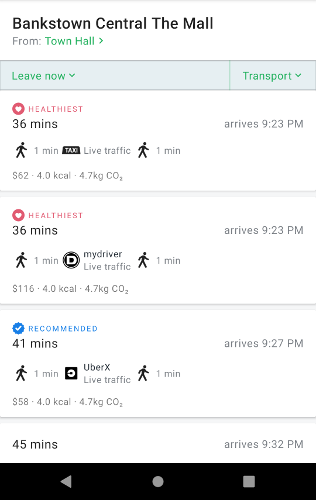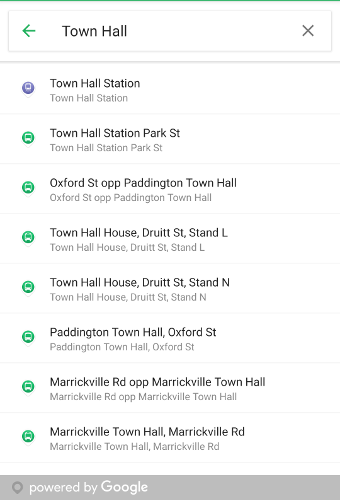View Controllers of TripKitUI
TripKitUI provides customizable view controllers for the following high-level features:
- Trip planning for showing and comparing the different ways of getting from A-to-B, including details screens for each trip both as an overview of the whole trip or the steps of each trip on a mode-by-mode basis.
- Public transport departures for a specific stop or station with real-time information, including a details screen for each service that shows the route on the map and in a list.
- Location search including autocompletion for searching by addresses, public transport POIs, or your own data sources.
- Customizable home screen which ties all of these together, and let's you add additional custom components
Each of these share the following characteristics:
- Customisation points for colours and fonts
- VoiceOver accessible
- Translated into the following languages: Arabic, English, Japanese,
- Compatible with Android Phone and Tablet
- Compatible with Android API 34
- Compatible with Google Map out of the box, but can also use other map UI layers, such as HERE or OpenStreetMap
- Source code available
Real-time departures and service details

The stand-alone view controller TKUITimetableControllerFragment let's you quickly and easily embed public transport departures.
This view controller has the following features:
- Show departures for an individual stop or larger station
- Real-time information where available, including real-time departure and arrival times, service disruptions and crowdedness of individual services.
- Optionally with wheelchair accessibility information
- Let users set the time of the first departure time
- Show details of each service
- Route on the map
- List of stops including arrival and departure time at each stop
- Real-time vehicle location where available
It has the following additional customisation point/s: - Customizable list of action buttons
Trip planning and trip details

The stand-alone view controller TKUITripResultsFragment let's you quickly and easily show routing results between two locations for various modes including combinations of those modes, i.e., this is fully multi-modal and inter-modal.
This view controller has the following features:
- Show routing results to a specified location from the user's current location, or between specified locations
- High-level comparison of trips, showing durations, cost, carbon emissions, and calories burnt
- Real-time information, including departure times, traffic, service disruptions, pricing quotes, ETAs
- Let users select what modes should be included
- Let users set the time to depart or the time to arrive
- Show details for each trip as an overview
Trip mode-by-mode overview

The stand-alone view controller TKUITripDetailsViewControllerFragment let's you display details of a trip on a mode-by-mode (or segment-by-segment) basis.
This view controller has the following features:
- Present detailed trip information, including origin, destination, modes of transportation, stops, and schedules.
- Supports various trip sources: individual trips (ViewTrip), groups of trips (TripGroup), and favorite trips (FavoriteTrip).
Location search

The TKUILocationSearchViewControllerFragment can be used to provide autocompletion results for addresses, POIs and custom data sources.
It features the following: - Location Search: - You can type in the name of a place, like a restaurant or a city, and the app will help you find it. - Map Integration: - If you want to search for places on a map, this code lets you do that. You can set an area on the map to focus your search. - Suggestions: - It gives you suggestions as you type, like when your phone suggests words when you're texting. These suggestions can be for specific places or types of locations.
Home screen
The TKUIHomeViewControllerFragment can be used as a start-screen for the trip planning, timetable and search components -- while being highly customizable to add arbitrary other features.
The built-in functionality is a search bar at the top, which uses the same search functionality as the dedicated TKUILocationSearchViewControllerFragment but with the search integrated in the home screen UI, along with a directions button to bring up the RouteInputView.
The purpose of the home screen is then to add individual components, to give users quick access to different section. How to build these, is up to you, but they can be things like:
- The user's favourites
- Recently searched locations
- Nearby locations
- Access to the user's booked trips
- Access to the user's tickets
The TripKitUIExample shows to do some of these.